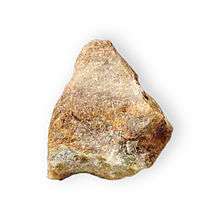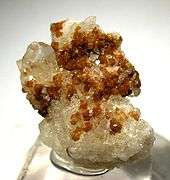Svanbergite
Svanbergite is a colorless, yellow or reddish mineral with the chemical formula SrAl3(PO4)(SO4)(OH)6. It has rhombohedral crystals.[3]
| Svanbergite | |
|---|---|
 Svanbergite with pyrophyllite and andalusite | |
| General | |
| Category | Phosphate minerals |
| Formula (repeating unit) | SrAl3(PO4)(SO4)(OH)6 |
| Strunz classification | 8.BL.05 |
| Crystal system | Trigonal |
| Crystal class | Hexagonal scalenohedral (3m) H-M symbol: (3 2/m) |
| Space group | R3m |
| Unit cell | a = 6.970–6.992 Å c = 16.567–16.75 Å, Z = 3 |
| Identification | |
| Color | Colorless, cream-yellow, rose, reddish brown |
| Crystal habit | Rhombohedral crystals (to pseudocubic); granular, massive |
| Cleavage | Distinct on {0001} |
| Mohs scale hardness | 5 |
| Luster | Vitreous to adamantine |
| Diaphaneity | Translucent |
| Specific gravity | 3.22 |
| Optical properties | Uniaxial (+) |
| Refractive index | nω = 1.631–1.635 nε= 1.646–1.649 |
| Birefringence | δ=0.0140-0.0150 |
| References | [1][2] |
It was first described for an occurrence in Varmland, Sweden in 1854 and named for Swedish chemist Lars Fredrik Svanberg (1805–1878).[1][2]
It occurs in high aluminium medium-grade metamorphic rocks; in bauxite deposits and from sulfate enriched argillic alteration ( high silica and clay) associated with hydrothermal systems often replacing apatite. It occurs with pyrophyllite, kyanite, andalusite, lazulite, augelite, alunite, kaolinite and quartz.[1]

Svanbergite crystals on white dolomite from Radium Hot Springs, British Columbia, Canada (size: 3 x 2.5 x 2.1 cm)
References
| Wikimedia Commons has media related to Svanbergite. |
- Mineral Handbook
- Webmineral
- Richard V. Gaines, H. Catherine W. Skinner, Eugene E. Foord, Brian Mason, and Abraham Rosenzweig: "Dana's new mineralogy", p. 962. John Wiley & Sons, 1997
This article is issued from Wikipedia. The text is licensed under Creative Commons - Attribution - Sharealike. Additional terms may apply for the media files.